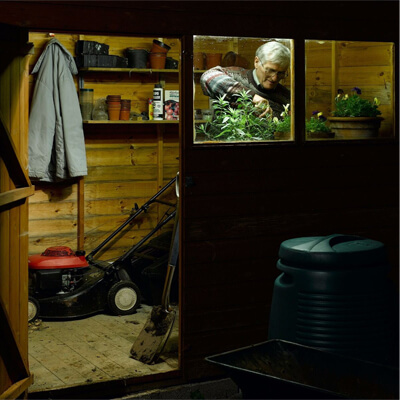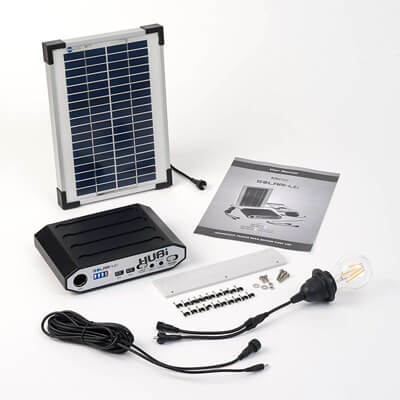
Running power to shed spaces is a fantastic way to upgrade your garden area. It is a transforming project that turns a simple storage area into a buzzing workshop, a cosy art studio, or even the hub for garden parties. But electrifying your shed is more than just a weekend DIY project. It involves careful planning, safety, and adhering to regulations.
If you're thinking of buying one of our garden workshops, log cabins or summerhouses, you clearly have bigger ideas beyond just storage – maybe a hobby room, a garden gym, or a garden office. For those, you’ll need to get power down to your garden building for lighting and for your electrical appliances. We now explore how your powered-up shed becomes a versatile and thrilling extension of your home.
Editor’s Note [15.12.23]:
The original article about adding power to sheds and other garden buildings was posted in January 2017. Today has seen a major update with new sections including adding electricity to a shed, the benefits of a shed with electricity, the need for safety checks and ongoing maintenance as well as a new conclusion section. In addition, enhancements have been added throughout the entire existing article.
Adding electricity to a shed – a transformational project
Adding power to your shed is a transformational project. It converts a basic storage space into something far more useful and fun. From a buzzing workshop with all your power tools to a cosy nook for your art, the possibilities are endless. If you are into hosting garden parties, well, say hello to your new favourite spot with all the lights and tunes.
Remember though safety first, always stick to the rules when running power to a shed. This is not just about making your shed better; it is about making it a versatile, super valuable extension of your home. So, go on, give your shed the power boost it deserves and watch how it revamps your garden experience.
Know your domestic electricity to shed regulations
The first thing to appreciate about running power to a shed or garden building is that it’s not very practical (or safe) to run an extension cable from a socket in your house. That might be OK for the odd DIY project in dry weather but certainly not as a long-term solution!
Since January 2005, major domestic electrical installations in England and Wales must comply with part P building regulations. This includes the laying of any electrical cable from your house to a garden building as well as the other electrical work associated with getting power outside from your main domestic supply. There is no shortcut here as you will need the necessary certification if you try to sell your property. There is also the issue of your liability should a non-certified, sub-standard electrical installation damage your, or your neighbour's, property, persons and/or pets.
However, there are exemptions. For example, if you already have power in your garden building and you just want to add more lighting or power points to an existing circuit, you probably won’t need certification.
Though you can do your own electrical work if you think you're competent enough to do so, it should ideally be undertaken by a professional electrician and preferably by a NICEIC-registered electrician. NICEIC enables you to find reputable electricians who are registered to certify their own work to the relevant building regulations. Remember that if you do the work to power up your garden building or if the qualified electrician who does the work is not NICEIC-registered, you’ll need to submit a building notice to your local authority and pay a building-control fee to get an electrical installation certificate (EIC).


Running power to a shed or other garden building with an electrical cable
Whether you plan to lay the electrical cable above ground or under it, you’ll need to use a Steel Wire Armoured cable (SWA).
Running the SWA cable below ground is the preferred option as this will hide an otherwise ugly cable snaking its way along your garden boundary to your garden building. There are additional considerations when sinking it though: the cable will need to be buried to a depth of at least 1 metre to comply with building regulations. You should also lay warning tape under the earth along the run of the cable but at a higher level (about 6" or 15cm below the surface). The reason for these measures is to reduce the risk of the more energetic gardeners amongst us inadvertently trying to dig up or cut the cable!
If you do decide to lay the cable above ground (or along your fence), you are quite within your rights to do so providing it is a) SWA cable, b) the installation has been certified to part P building regulations and c) it’s on your side of the legal boundary. However, it’s worthwhile discussing your plans first with your neighbours - it might be that the additional effort/cost of burying the cable is worth it just to keep on friendly terms.
Benefits and uses of a shed with electricity
Adding electricity seriously increases the valuableness of a shed. Here is why you should consider running power to a shed:
- All-weather use - no more freezing winters or sweltering summers with proper climate control
- Art studio illuminated - perfect lighting for your artistic and craft endeavours
- Cosy reading nook - settle in with a good book and a warm light
- Entertainment hub - fit a TV or a gaming console for a perfect retreat
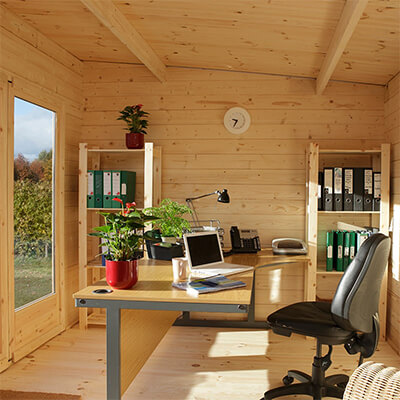

- Home office potential - swap your spare room for a tranquil garden office
- Safety first – a shed with electricity means security lights and cameras can be installed
- Storage plus - keep your technology gadgets safely charged and stored
- Workshop heaven - power tools? No problem, a shed with electricity is a DIYer’s dream
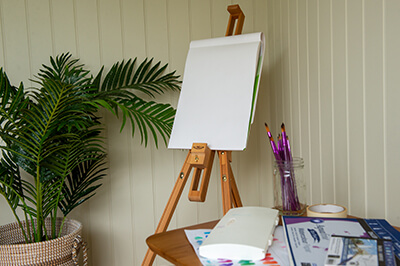

- Fitness studio – power up your exercise equipment for a home gym setup
- Garden parties - lights and music systems turn your shed into a garden party zone
- Grow plants - electricity supports hydroponic or heated systems for plants
- Hobby headquarters - whatever your hobby, electricity takes it up a notch
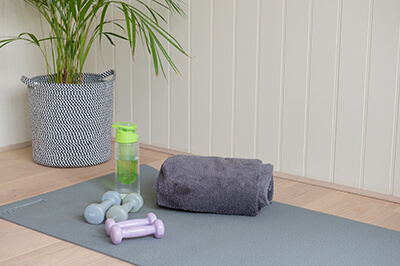

Remember, when adding electricity to shed regulations should always be followed to ensure full regulatory and legislative safety and compliance.
Safety checks and ongoing maintenance
Having an electric-powered shed is wonderful but to keep it that way requires safety checks and ongoing maintenance. This is essential for safety and ongoing usage reasons. The adage “prevention is better than cure” certainly applies.
Tips on maintaining your shed's electrical system
If you follow these tips, you will ensure that your garden shed electricity system is safe and will last for many years to come:
- Fuse box awareness - as in a house, be aware of where your fuse box is and be ready to take quick action where needed
- Gadget check - ensure that all electrical devices within the shed are free of electrical defects
- Keep the shed dry - ensure that your shed stays dry inside, this will help to prevent electrical incidents
- Lighting – verify periodically that light fittings are secure and in good condition
- Professional check - use a qualified electrician to check your electricity setup periodically (preferably through an annual checkup)
- Routine inspection – have standard inspection intervals to spot and fix any issues as early on as possible
- Socket safety - check sockets for “wear and tear” and any signs of damage or overheating
- Tidying of cables - keep cables neatly organised, this avoids trips and reduces cable damage
- Tripping out - trip switches need to be checked every few months
- Wiring checks - regularly check for any frayed or exposed wires
Solar power for sheds
We could not complete our article about bringing power to shed spaces without mentioning solar power.
Choosing solar-powered outdoor lights is an efficient and cost-effective way to brighten up your garden shed.
They are not only energy-efficient, running solely on solar power without any ongoing electricity costs, but they are also easy to install with a range of stylish designs. They are weatherproof, making them ideal for the British climate, although their effectiveness may vary in the winter months due to reduced sunlight. What’s more, is that this provides a way to deliver power to shed tools and lighting systems using a sustainable energy source.
For everything you need to know on bringing power to shed and outbuildings using solar, read our Harnessing Solar Power for Sheds Solar Panels & Lighting Ideas article.
Conclusion
In summary, powering your shed is the same as giving it an enormous boost. It transforms a run-down shed into something amazing, turning it into your new hangout or a busy workshop. But remember, it is always better to be safe when it comes to electricity. Respect those rules and do not hesitate to consult an expert when needed to maintain ethics.
Regular maintenance is essential to safely maintaining the energy supply in your shed for many years after everything is up and running. That is, it; go ahead and electrify your shed, lock it, and relish all the garden-related options it offers.
Contact Buy Sheds Direct
We hope you have enjoyed this post about running power to a shed. Speak to our team about our range of sheds and we can advise about the best methods of buying a shed with electricity. Contact methods include:
- Phone us - 0333 003 0514
- E-mails – click on our contact form to send emails
- Text chat – speak to us in real-time using our live chat app

